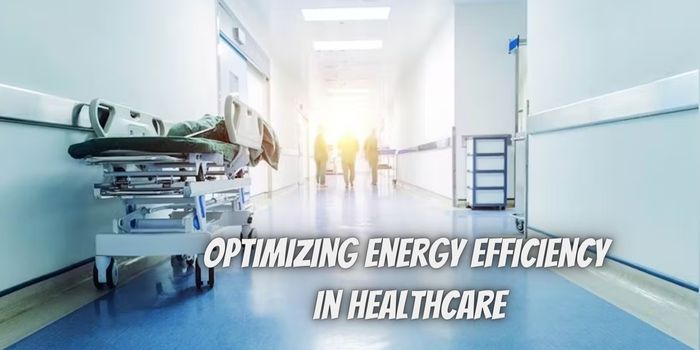It’s a lesser-known fact that the healthcare industry is a significant energy consumer globally, with hospitals and healthcare facilities accounting for a sizable portion of total energy use.
This energy consumption is driven by the need to operate 24/7 and the high demand for specific systems such as lighting, heating, cooling, and medical equipment. Therefore, optimizing energy efficiency in healthcare facilities is a critical issue that requires immediate attention.
The Importance of Energy Efficiency in Healthcare
In addition to the substantial financial savings that could be realized, optimizing energy efficiency in healthcare facilities has several other benefits. First, it reduces the environmental footprint of these facilities.
With climate change posing significant threats to global health, the healthcare sector has a responsibility to mitigate its impact on the environment. Second, energy-efficient hospitals can provide better patient care. Improved indoor air quality, reduced noise pollution, and enhanced patient comfort are all benefits of energy-efficient design.
Strategies for Optimizing Energy Efficiency
There are several strategies that healthcare facilities can employ to optimize their energy efficiency. The first step is often conducting a comprehensive energy audit to understand the facility’s current energy consumption patterns and identify areas for improvement.
Building Design and Retrofitting: The design of a healthcare facility can significantly impact its energy efficiency. Optimizing the building envelope, including walls, windows, roofs, and floors, can dramatically reduce energy waste.
High-performance building materials and technologies, such as energy-efficient windows and insulation, can help control indoor temperatures and reduce need for heating and cooling. Moreover, retrofitting existing buildings with these materials and technologies can also yield substantial energy savings.
Energy-Efficient HVAC Systems: Heating, ventilation, and air conditioning (HVAC) systems, as stated earlier in this article, consume and require a significant portion of energy use in healthcare facilities. Implementing energy-efficient HVAC systems, combined with regular maintenance to ensure they continue to operate optimally, can result in significant energy savings.
Lighting Systems: Lighting accounts for a significant portion of a healthcare facility’s energy use. Switching to energy-efficient lighting solutions, such as LED lights, can significantly reduce energy consumption. Additionally, the use of natural light can not only save energy but also improve patient well-being.
Energy Management Systems: The use of energy management systems (EMS) can help healthcare facilities monitor, control, and optimize their energy use. EMS can identify energy waste, provide actionable insights, and automate energy-saving measures.
Behavioral Changes: Simple behavioral changes can also lead to significant energy savings. These can include turning off lights and equipment when not in use, using energy-efficient settings on devices, and training staff on energy-saving practices.
Innovations in Energy Efficiency
The field of energy efficiency is continually evolving, with new technologies and innovations emerging regularly. Below are listed a few that are particularly relevant for healthcare facilities:
Renewable Energy Sources: Harnessing renewable energy sources, like solar and wind power, can significantly reduce a healthcare facility’s reliance on non-renewable energy sources. In addition, battery storage systems can store excess renewable energy for use during periods of high demand or low supply.
Internet of Things (IoT) and AI: IoT devices can monitor and control various aspects of a building’s energy use, from lighting and temperature to the operation of medical equipment. When combined with artificial intelligence (AI), these devices can analyze energy use patterns, predict future energy needs, and automatically adjust systems to optimize energy efficiency.
Green Roofs and Walls: Green roofs and walls, covered with vegetation, can provide insulation, reducing the need for heating and cooling. They also have a positive impact in improving air quality and providing a healing environment for patients.
Microgrids: Microgrids are localized energy grids that can operate independently of the traditional grid. They can generate, distribute, and regulate the flow of energy in a facility, offering resilience in case of power outages and reducing reliance on the main power grid. By integrating renewable energy sources and storage systems, microgrids can also contribute to a facility’s overall energy efficiency.
Co-generation Systems: Co-generation or combined heat and power (CHP) systems simultaneously produce electricity and useful heat from the same energy source. By utilizing the heat that would otherwise be wasted, these systems can achieve efficiency levels of up to 80-90%. For healthcare facilities that need both electricity and heat, co-generation systems can offer significant energy and cost savings.
Future Directions : Going forward, there are promising opportunities for further optimization of energy efficiency in healthcare facilities. For example, advancements in AI and machine learning could enable even more sophisticated energy management systems capable of predictive modeling and real-time optimization.
In addition, as the healthcare industry moves towards more patient-centered care, there is a growing interest in how energy-efficient design can contribute to patient well-being. Studies have shown that natural light, good air quality, and comfortable temperatures can speed up recovery times, reduce the need for medication, and improve patient satisfaction.
Finally, the adoption of widely recognized green building standards such as LEED and BREEAM can provide a roadmap for healthcare facilities looking to improve their energy efficiency.
The Role of HIMSS in Energy Efficiency
As an influential organization in the healthcare sector, HIMSS (Healthcare Information and Management Systems Society), plays a critical role in promoting and implementing energy efficiency strategies. With its focus on improving health through the use of information and technology, HIMSS is well-positioned to drive innovation in energy efficiency.
The impact of HIMSS on the healthcare industry extends to the crucial area of energy optimization, demonstrating how strategic application of technology can reduce potential costs and also enhance the quality of care.
HIMSS’s Proactive Steps in Energy Optimization
Recognizing the need for energy efficiency in healthcare, HIMSS has taken proactive steps to optimize it. Through their initiatives and collaborations, they provide resources, best practices, and tools to assist healthcare facilities in their journey towards energy optimization. The influence of HIMSS in this sphere is substantial, helping to shape the way healthcare facilities approach energy use.
Integration of IT in Energy Management
One of the ways HIMSS contributes to energy efficiency in healthcare is by promoting the integration of information technology (IT) into energy management. As part of this, they encourage the use of advanced data analytics to monitor and control energy use.
This strategy, spearheaded by HIMSS, allows healthcare facilities to better understand their energy consumption patterns and identify potential areas for savings, demonstrating the tangible impact of HIMSS’s initiatives on the healthcare industry.
Championing Advanced Technology for Energy Management
In its continued effort to enhance energy efficiency, HIMSS champions the use of advanced technologies, for example, the most common being, AI and the IoT (Internet of Things) in energy management.
By utilizing these technologies, healthcare facilities can automate energy-saving measures, predict future energy needs, and optimize their systems to maximize energy efficiency. This is a clear example of how HIMSS is making a significant impact on the healthcare industry by integrating cutting-edge technologies into everyday operations.
Education and Awareness: An Integral Part of HIMSS’s Impact
Moreover, HIMSS promotes education and awareness about energy efficiency. Through their conferences, webinars, and publications, they provide a platform for sharing knowledge and experiences about energy efficiency in healthcare.
This way, they play a crucial role in driving behavioral changes, which are often one of the most effective ways to achieve energy savings. By promoting a culture of energy consciousness, HIMSS’s impact on the healthcare industry extends beyond the technical and into the realm of sustainable practices and attitudes.
A Bright and Sustainable Future
The drive to optimize energy efficiency in healthcare facilities is not just about reducing energy consumption and costs. It’s about creating a healthier and more sustainable future for all. The strategies and innovations outlined in this article provide a path towards this goal.
By harnessing the power of technology, embracing sustainable design principles, and fostering a culture of energy consciousness, healthcare facilities can significantly reduce their environmental footprint, improve patient care, and pave the way for a greener healthcare industry.




